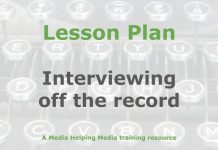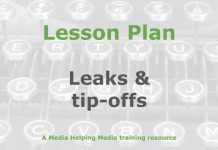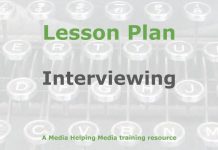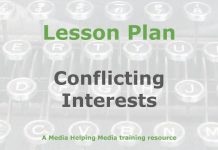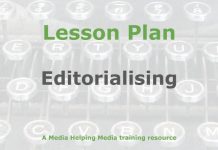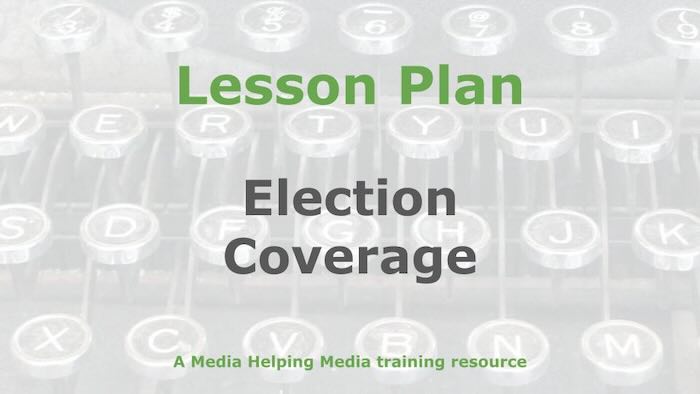 This lesson plan is designed for trainers to adapt in order to teach students the essential considerations required for journalists covering an election.
This lesson plan is designed for trainers to adapt in order to teach students the essential considerations required for journalists covering an election.
It’s based on the article ‘Planning tips for effective election coverage‘ which is published on Media Helping Media and which we recommend you read before adapting this lesson for your own purposes.
Learning objective
Students will evaluate and apply effective planning strategies for election coverage, focusing on adapting a comprehensive checklist in order to ensure that no element is missed. They will also analyse the roles and responsibilities within an election coverage team to ensure thorough reporting.
- Student-facing objective: By the end of this lesson, I’ll be able to use a checklist to plan election coverage and understand the different roles needed for balanced reporting.
- Standards: Students will learn how best to plan election coverage.
Learning activities
Warm-up
Begin with a brief discussion on the importance of planning in journalism. Ask students to share any experiences or knowledge they have about planning events or projects. Then, introduce an imaginary scenario such as planning a local council election where they live.
- Prompt: “Imagine you’re planning a local council election in your home town, what details do you need to consider? Think about dates, rules, candidates, parties, your budget, and what the audience needs to know.”
- Activity: In pairs, students brainstorm a list of considerations for the local election. After a few minutes, ask pairs to share their ideas with the class.
- Transition: Highlight how these considerations relate to planning coverage for an actual election, setting the stage for the lesson’s focus on detailed planning and roles.
Direct instruction
Introduce the Election Planning Checklist: Present the election planning checklist (see ‘Planning tips for effective election coverage‘ if you need to refresh your memory). Explain that the checklist is designed to be a comprehensive tool for organising election coverage. Explain each section briefly, emphasising its importance in ensuring thorough and fair reporting. Use real-world examples, such as a recent election, to illustrate how each checklist item might be applied.
Analyse roles and responsibilities: Discuss the various roles within an election coverage team. Highlight the importance of collaboration across departments. Use a case study of a media organisation to show how different roles contribute to effective coverage. Encourage students to think about how they would assign roles based on skills and expertise.
Adaptation to local realities: Explain the necessity of adapting the checklist to local contexts. Provide a scenario where students must adjust the checklist for a hypothetical local election with limited resources. Guide them through identifying which elements are most critical and how they might creatively address constraints.
Guided practice
Think, Pair, Share: Facilitate a collaborative activity to deepen understanding of election coverage planning.
Think: Ask students to individually review the election planning checklist. Instruct them to select one item they find most critical for effective election coverage and think about why it is essential.
- Pair: Have students pair up to discuss their chosen checklist item. Encourage them to explain their reasoning and listen to their partner’s perspective.
- Share: Invite pairs to share their insights with the class. Facilitate a discussion on the diversity of opinions and the importance of each checklist item.
- Connect: Guide students to connect their discussions to real-world scenarios. Ask them to consider how their chosen item might be adapted to a local election context.
- Reflect: Conclude with a reflection on how collaboration and diverse perspectives enhance planning. Encourage students to consider how they might apply these insights in future projects.
Independent practice
Exercise: Assign students to individually create a detailed plan for election coverage using the checklist. They should focus on adapting it to a hypothetical local election scenario with limited resources.
Task: Instruct students to prioritise the checklist items, explaining their choices and how they would address potential constraints.
Observation: Circulate to provide guidance and answer questions as students work on their plans.
Assignment
Ask students to answer these questions:
- Which checklist item do you think is most challenging to adapt to local realities, and why?
- How can collaboration among different roles enhance election coverage planning?
- What’s one question you still have from today’s lesson?
Here are some suggested answers:
- Suggested answer to Question 1: Adapting the budget item can be challenging due to varying financial constraints and resource availability.
- Suggested answer to Question 2: Collaboration ensures diverse perspectives and expertise, leading to more comprehensive and balanced coverage.
Teacher resources
Differentiation guide
- Advanced learners: Encourage them to explore additional roles and responsibilities within election coverage teams, such as data analysis or investigative reporting. Suggest they research how different media outlets handle election coverage globally and present their findings to the class.
- Striving learners: Provide simplified versions of the election planning checklist. Pair them with peers for collaborative activities to ensure understanding. Offer additional examples and scenarios to help them grasp the concepts. Use visual aids to illustrate the roles and responsibilities within an election coverage team.
- Background reading: This lesson plan is based on the article ‘Planning tips for effective election coverage‘ which we recommend you read before adapting this lesson for your own purposes.
Notable definitions
- Electoral commission: A body responsible for overseeing the conduct of elections, including the management of electoral rolls and the enforcement of election laws.
- Poll watching: The act of observing the conduct of an election to ensure fairness and transparency, often carried out by representatives of political parties or independent organisations.
- Media monitoring group: A collective of non-partisan individuals tasked with overseeing media coverage during an election to protect press freedom and investigate any incidents of harassment or bias.
Required materials
- Election planning checklist: Copies for each student.
- Case study materials: Example of a media organisation’s election coverage plan.
- Scenario cards: Hypothetical local election scenarios for adaptation exercises.
- Reflection sheets: For students to record insights and reflections.
- Writing materials: Pens, paper, or digital devices for note-taking and planning.
- Visual aids: Charts or slides illustrating roles and responsibilities in election coverage.
- Discussion prompts: Prepared questions for pair and class discussions.
Lesson summary
- Warm-up
- Direct instruction
- Guided practice
- Independent practice
- Assignment
The free teaching tools at the Khan Academy were used in the production of this lesson plan.


